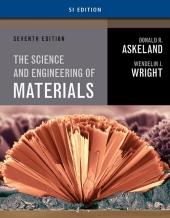 Neuerscheinungen 2015Stand: 2020-02-01 |
Schnellsuche
ISBN/Stichwort/Autor
|
Herderstraße 10
10625 Berlin
Tel.: 030 315 714 16
Fax 030 315 714 14
info@buchspektrum.de |

Donald R. Askeland, Wendelin J. Wright
(Beteiligte)
Science and Engineering of Materials, SI Edition
7th ed. 2015. 960 p. 277 mm
Verlag/Jahr: CENGAGE LEARNING EMEA; NELSON ENGINEERING 2015
ISBN: 1-305-07710-5 (1305077105)
Neue ISBN: 978-1-305-07710-2 (9781305077102)
Preis und Lieferzeit: Bitte klicken
This updated Seventh Edition of THE SCIENCE AND ENGINEERING OF MATERIALS helps you to develop an understanding of the relationship between structure, processing, and properties of materials. Because the book has more material than is needed for a one-semester course, you will also have a useful reference for subsequent courses in manufacturing, materials, design, or materials selection.
The Askeland text emphasizes a science-based approach to materials engineering that highlights how the structure of materials at various length scales gives rise to materials properties. This connection between structure and properties is key to innovating with materials, both in the synthesis of new materials and enabling new applications with existing materials. The science-based approach highlights how materials change with time and due to loading and environment - a key concept that is often overlooked when using charts and databases to select materials.
1. Introduction to Materials Science and Engineering.
2. Atomic Structure.
3. Atomic and Ionic Arrangements.4. Imperfections in the Atomic and Ionic Arrangements.
5. Atom and Ion Movements in Materials
6. Mechanical Properties: Part One.
7. Mechanical Properties: Part Two.
8. Strain Hardening and Annealing.
9. Principles of Solidification.
10. Solid Solutions and Phase Equilibrium.
11. Dispersion Strengthening and Eutectic Phase Diagrams.
12. Dispersion Strengthening by Phase Transformations and Heat Treatment.
13. Heat Treatment of Steels and Cast Irons.
14. Nonferrous Alloys.
15. Ceramic Materials.
16. Polymers.
17. Composites: Teamwork and Synergy in Materials.
18. Construction Materials.
19. Electronic Materials.
20. Magnetic Materials.
21. Photonic Materials/
22. Thermal Properties of Materials.
23. Corrosion and Wear.
Appendix A: Selected Physical Properties of Materials.
Appendix B: The Atomic and Ionic Radii of Selected Elements.
Wright, Wendelin
Dr. Wendelin Wright is a professor at Bucknell University with a joint appointment in the departments of Mechanical Engineering and Chemical Engineering. She received her B.S., M.S., and Ph.D. in Materials Science and Engineering from Stanford University. Prior to assuming her position at Bucknell, Dr. Wright was a faculty member at Santa Clara University. Her research interests focus on the mechanical behavior of materials, particularly those of metallic glasses. She is the recipient of the 2003 Walter J. Gores Award for Excellence in Teaching (Stanford University´s highest teaching honor), a 2005 Presidential Early Career Award for Scientists and Engineers, and a 2010 National Science Foundation CAREER Award. Dr. Wright is a licensed professional engineer in metallurgy in California and a Fellow of ASM International.
Askeland, Donald
Dr. Donald R. Askeland joined the University of Missouri-Rolla (now the Missouri University of Science and Technology) in 1970 after obtaining his doctorate in Metallurgical Engineering from the University of Michigan. His primary interest is teaching, which has resulted in a variety of campus, university, and industry awards and the development of THE SCIENCE AND ENGINEERING OF MATERIALS textbook. Dr. Askeland is also active in research involving metals casting and metals joining, particularly in the production, treatment, and joining of cast irons, gating and fluidity of aluminum alloys, and optimization of casting processes. Additional work has concentrated on lost foam casting, permanent mold casting, and investment casting. Much of this work is interdisciplinary, providing data for creating computer models and validation of such models.


